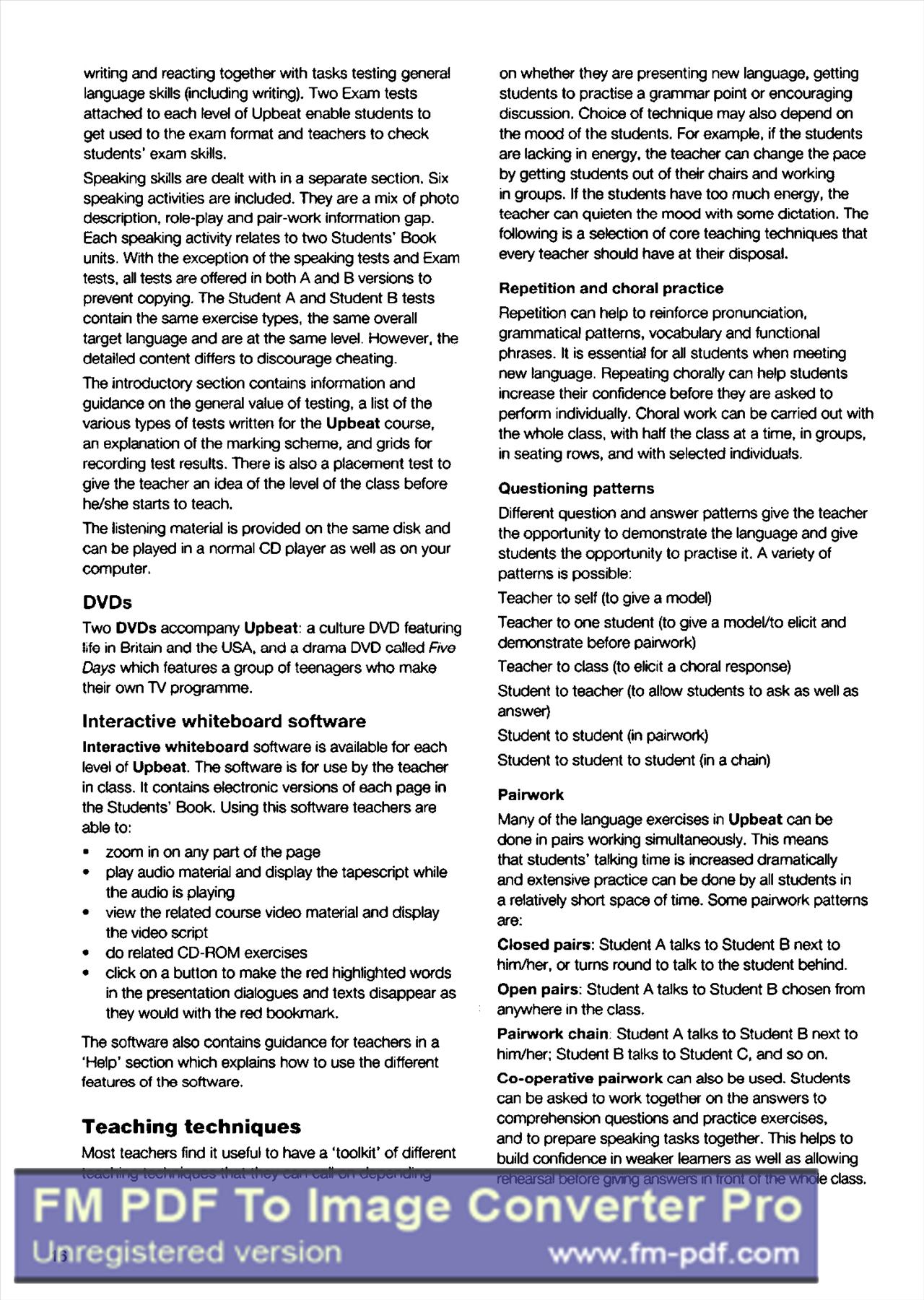Up¾at 3 Teacher's Book podrecznik nauczyciela plus odpowiedzi ,testy,klucz answer key Page 015

MMMMM
writing and reacting together with tasks testing genera! language skills (including writing). Two Exam tests attached to each level of Upbeat enable students to get used to the exam format and teachers to check students’ exam skills.
Speaking skills are dealt with in a separate section. Six speaking activities are included. They are a mix of photo description, role-play and pair-work information gap. Each speaking activity relates to two Students’ Book units. With the exception of the speaking tests and Exam tests. all tests are offered in both A and B versions to prevent copying. The Student A and Student B tests contain the same exercise types, the same overall target language and are at the same level. However, the detailed content differs to discourage cheating.
The introductory section contains information and guidance on the generał value of testing, a list of the various types of tests written for the Upbeat course, an explanation of the marking scheme, and grids for recording test results. There is also a placement test to give the teacher an idea of the level of the class before he/she starts to teach.
The listening materiał is provided on the same disk and can be played in a normal CD player as well as on your Computer.
DVDs
Two DVDs accompany Upbeat: a culture DVD featuring life in Britain and the USA, and a drama DVD called Ftvo Days which features a group of teenagers who make their own IV programme.
Interactive whiteboard software
lnteractive whiteboard software is available for each level of Upbeat. The software is for use by the teacher in class. It contains electronic versions of each page in the Students’ Book. Using this software teachers are able to:
â– zoom in on any part of the page
• play audio materiał and display the tapescript while the audio is playing
• view the related course video materiał and display the video script
• do related CD-ROM exercises
• click on a button to make the red highlighted words in the presentation diaiogues and texts disappear as they would with the red bookmark.
The software also contains guidance for teachers in a ‘Help’ section which explains how to use the different features of the software.
Teaching techniques
Most teachers find it useful to have a ‘toolkrt’ of different
on whether they are presenting new language, getting students to practise a grammar point or encouragirtg discussion. Choice of technique may also depend on the mood of the students. For example. if the students are lacking in energy, the teacher can change the pace by getting students out of their chairs and working in groups. If the students have too much energy, the teacher can quieten the mood with some dictation. The following is a selection of core teaching techniques that every teacher should have at their disposal.
Repetition and chorał practice
Repetition can help to reinforce pronunciation, grammatical patterns, vocabulary and functional phrases. It is essential for all students when meeting new language. Repeating chorally can help students increase their confidence before they are asked to perform individually. Chorał work can be carried out with the whole class, with half the class at a time, in groups, in seating rows, and with selected individua!s.
Ouestioning patterns
Different questbn and answer patterns give the teacher the opportunity to demonstrate the language and give students the opportunity to practise it. A variety of patterns is possible:
Teacher to self (to give a model)
Teacher to one student (to give a model/to elicit and demonstrate before pairwork)
Teacher to class (to elicit a chorał response)
Student to teacher (to allow students to ask as well as answer)
Student to student (in pairwork)
Student to student to student (in a Chain)
Pairwork
Many of the language exercises in Upbeat can be done in pairs working simultaneousiy. This means that students’ talking time is increased dramatically and extensive practice can be done by all students in a re!atively short space of time. Some pairwork patterns are:
CÅ‚osed pairs: Student A talks to Student B next to him/her, or turns round to talk to the student behind.
Open pairs: Student A talks to Student B chosen from anywhere in the class.
Pairwork chain Student A talks to Student B next to him/her; Student B talks to Student C, and so on.
Co-operative pairwork can also be used. Students can be asked to work together on the answers to comprehension questions and practice exercises, and to prepare speaking tasks together. This helps to build confidence in weaker leamers as well as allowing TeRearsar^ofegMn^answers^Å‚ronTof TROTSe class.
13
Wyszukiwarka
Podobne podstrony:
Up?at 3 Teacher s Book podrecznik nauczyciela plus odpowiedzi ,testy,klucz answer key Page 025 po&am
Up?at 3 Teacher s Book podrecznik nauczyciela plus odpowiedzi ,testy,klucz answer key Page 130 Vocab
Up?at 3 Teacher s Book podrecznik nauczyciela plus odpowiedzi ,testy,klucz answer key Page 001 FM PD
Up?at 3 Teacher s Book podrecznik nauczyciela plus odpowiedzi ,testy,klucz answer key Page 005 Conte
Up?at 3 Teacher s Book podrecznik nauczyciela plus odpowiedzi ,testy,klucz answer key Page 006 Conte
Up?at 3 Teacher s Book podrecznik nauczyciela plus odpowiedzi ,testy,klucz answer key Page 009 FM PD
Up?at 3 Teacher s Book podrecznik nauczyciela plus odpowiedzi ,testy,klucz answer key Page 010 : Rea
Up?at 3 Teacher s Book podrecznik nauczyciela plus odpowiedzi ,testy,klucz answer key Page 012 Large
Up?at 3 Teacher s Book podrecznik nauczyciela plus odpowiedzi ,testy,klucz answer key Page 013 u mfo
Up?at 3 Teacher s Book podrecznik nauczyciela plus odpowiedzi ,testy,klucz answer key Page 014 selec
Up?at 3 Teacher s Book podrecznik nauczyciela plus odpowiedzi ,testy,klucz answer key Page 018 Sugge
więcej podobnych podstron